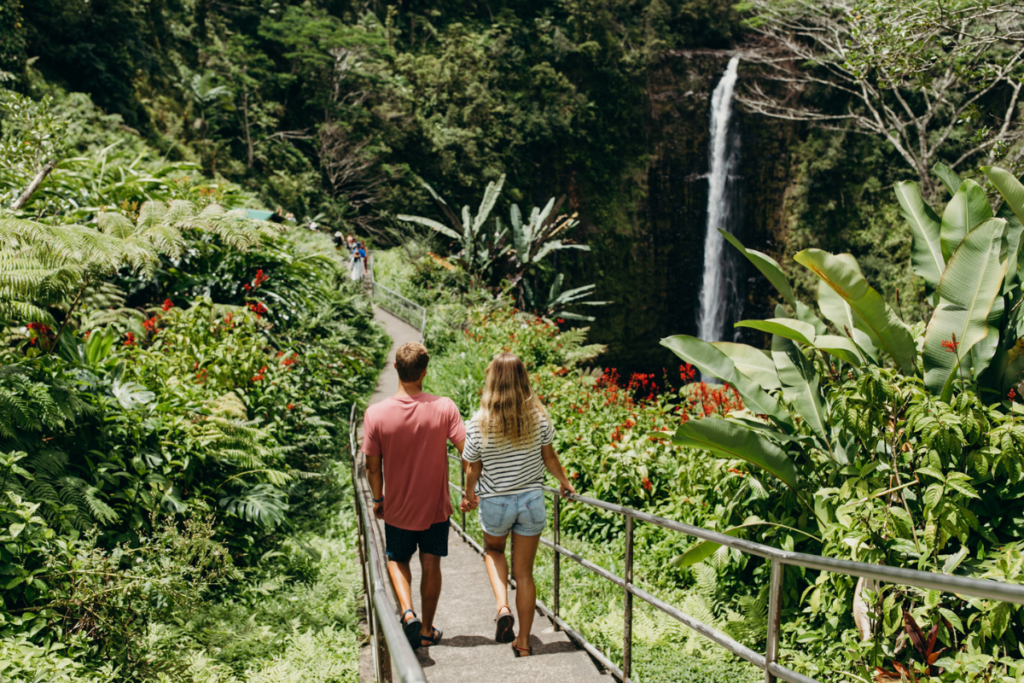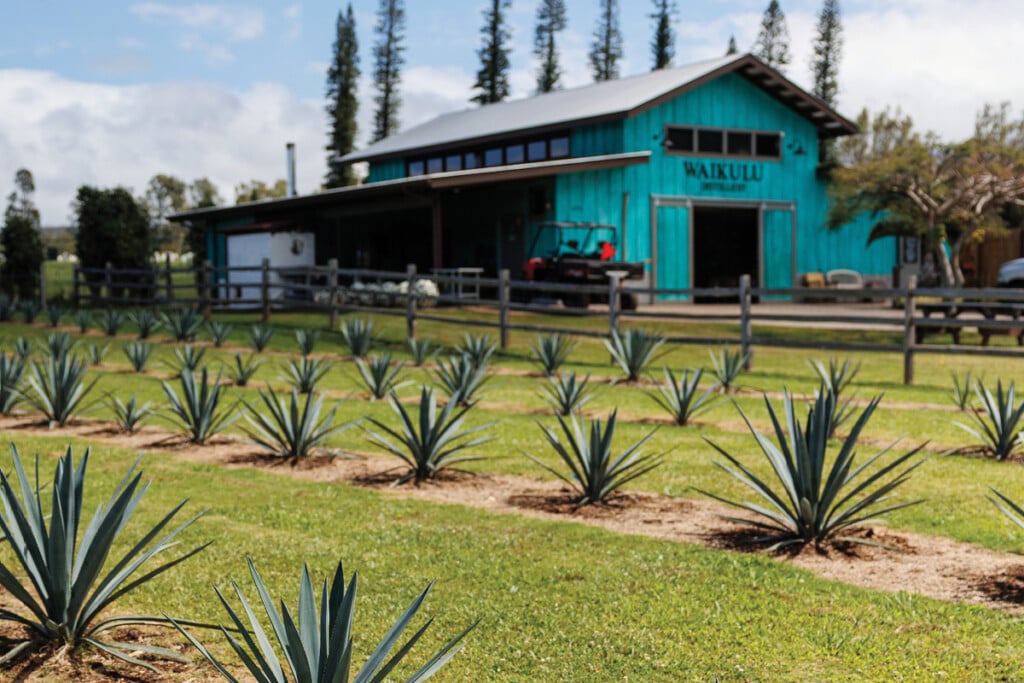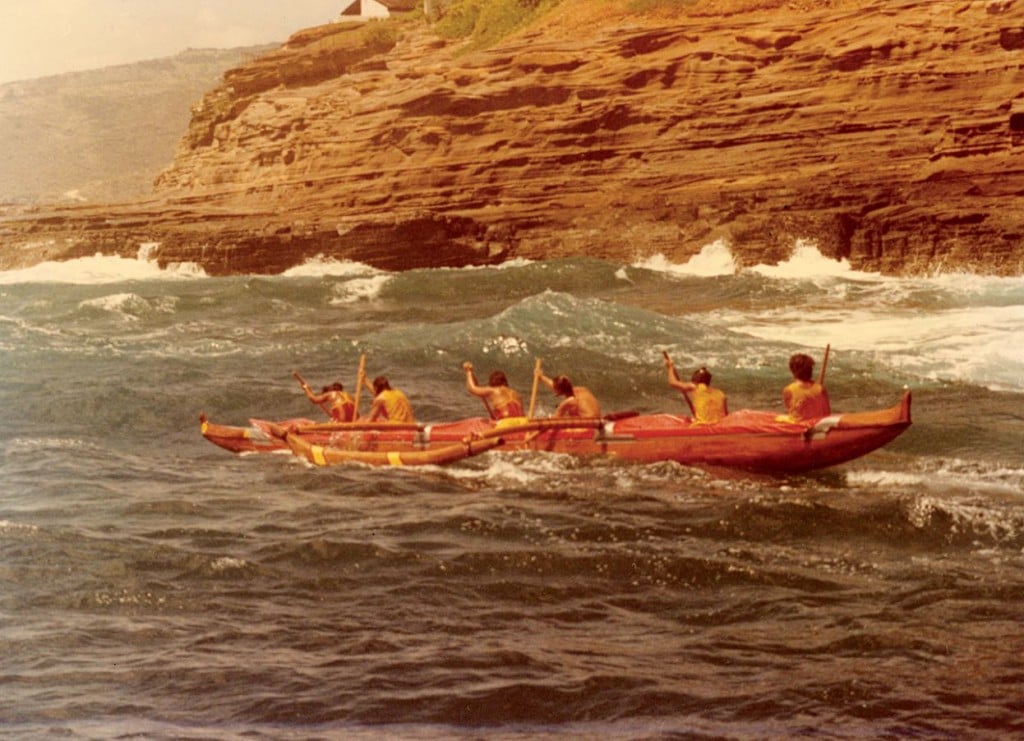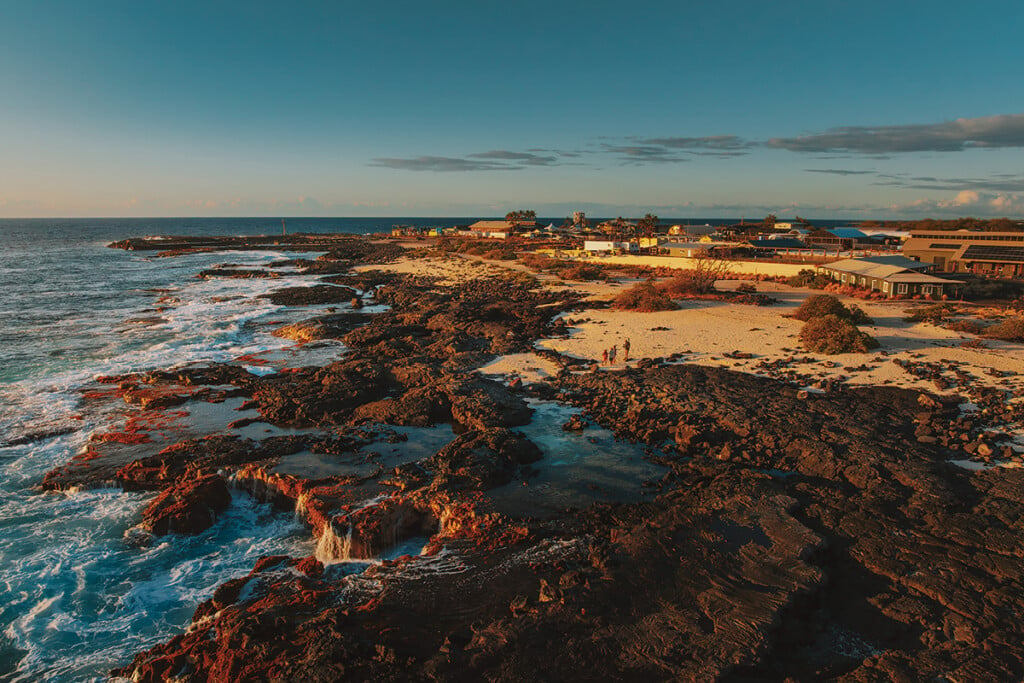12 Tips for Traveling to Hawaiʻi on a Budget
How to cut costs during your next trip to the Islands.

Hawai‘i, the most expensive U.S. State to live in, according to the world population review, can be an expensive vacation destination, too. But with some insider tips, you can significantly reduce the cost of your tripand still check it off your bucket list. There are plenty of affordable (or free!) ways to enjoy the islands, including ditching the rental car; skipping the big resorts for smaller hotels; exploring off-the-beaten-path destinations; and supporting small mom and pop shops, which also benefits the local economy. Ready to save money, avoid crowds, and skip long lines? Let’s dive in!
1. Happy Hour Hopping

Checking happy hour (or pau hana) times and menus is a smart way to stretch your dollar.
Illustrations by Kelsie Dayna
Craving a resort pool bar or restaurant experience without the hefty price tag? Visit during happy hour. That’s when you’ll find special late-night menus, all-day discounts and affordable fresh seafood with a view. Checking happy hour (or pau hana) times and menus is a smart way to stretch your dollar. On O‘ahu, Mahina & Sun’s at the ultra-cool Surfjack Hotel & Swim Club in Waikīkī has happy hour from 11:30 a.m. to 5:30 p.m. daily poolside. Lost & Found at the Wayfinder Waikīkī, another pool bar serving fresh poke, offers 50% off craft cocktails, and Rivals at Waikīkī Malia has beer and pizza by the slice both for $7. In Pō‘ipu on Kaua‘i, visit Kalapakī Joe’s from 3 to 6 p.m. for 25-cent wings, $5 fish tacos and $2 coconut shrimp. The Sea House on Maui is famous for its happy hour bites; from 2 to 4:45 p.m. dine on Asian-style barbecue ribs with pineapple slaw for $9 and seared local ‘ahi with cucumber kimchi for $11. And on Hawai‘i Island visit The Temple Bar (located in Hilo and Kona) for Taco Tuesdays, 5 to 9 p.m. (half-off street tacos and margaritas); or Mondays to Fridays, 3 to 5 p.m. ($1 off all cocktails, craft beer and wine).
READ MORE: 6 Waikīkī Pool Bars on Oʻahu and What to Order
2. Eat Where The Locals Eat
Dive bars and mom and pop spots are the way to go when you’re tight on cash—and many of them serve generous portions. Kūhiō Grille on Hawai‘i Island serves not only breakfast, lunch and dinner with all the local hits from loco moco to kālua pig, but the portions are so big they can easily become two meals. (It is home to the 1-pound lau lau after all.) On Kaua‘i, hit up Mark’s Place for killer plate lunches and daily specials such as smoked marlin and ‘ahi katsu with garlic butter crab. Sheldon Simeon, renowned chef, cookbook author and “Top Chef” contestant, offers top value with elevated local cuisine at his restaurant-bar, Tiffany’s Maui in Wailuku, and his Tin Roof hole-in-the-wall in Kahului. A great bar in Honolulu is 8 Fat Fat 8 off South Beretania Street; the crisp Fat Fat Chicken is a must-try. In Downtown Honolulu, get a deal on killer smash burgers, fries and beer at The Daley.
READ MORE: Head to Chef Sheldon Simeon’s Newest Restaurant Venture for Local Favorites
3. Frugal Farmers Market Finds
Savor tropical fruits, fresh vegetables and a variety of affordable meals at a local farmers market. On O‘ahu, the Kaka‘ako Farmers Market (8 a.m. to noon Saturdays) boasts a dizzying array of local ingredients and cuisines from around the world. Visit Nasi Lemak for Malaysian coconut rice bowls, Fatto A Mano for Neapolitan-style sourdough pizza and Little Sparrow for loaded German spaetzle. On Maui, the Upcountry Farmers Market (7 to 11 a.m. Saturdays), near the island’s largest farms and ranches, offers an abundance of local produce. The Kaua‘i Culinary Market (3:30 to 6 p.m. Wednesdays) offers a wine and beer garden in addition to food, plus a free cooking demonstration at 5 p.m. And on Hawai‘i Island, Hilo has multiple choices, including a daily farmers market (7 a.m. to 3 p.m.) at Māmo Street and Kamehameha Avenue, with towering stands of fresh fruit, including local mangosteen, white pineapple and Big Island lychee (when in season), and the evening Hilo Town Market every Friday (5 to 9 p.m.) at 69 Waiānuenue Ave., which includes live music, prepared food and locally made crafts.
READ MORE: These Farmers Market Finds are Worth the Search on Oʻahu
4. Chill At A Park

Hawai‘i is home to some of the most stunning parks in the world.
Illustrations by Kelsie Dayna
Hawai‘i is home to some of the most stunning parks in the world, but not all are free to enter. Before you go, check online to make sure the park you are visiting doesn’t charge a parking and/or admission fee. Kapi‘olani Park on O‘ahu has 200 acres of open, grassy fields that are great for picnicking and relaxing. On Kaua‘i, Ke Ala Hele Makālae has an 8-mile path for walking, jogging and biking along the coastline, and Wailua River State Park is filled with lush forests, waterfalls and rivers. Keōpūolani Regional Park, Maui’s largest park, offers 110 acres of recreational space adjacent to the Maui Arts and Cultural Center. Hawai‘i Island’s Kalōpā State Recreation Area in Hāmākua is in a native ‘ōhi‘a forest 2,000 feet above sea level, while Lili‘uokalani Gardens in Hilo—a Japanese garden built as a tribute to Hawai‘i’s first Japanese immigrants—boasts manicured pathways, lagoons, pagodas, spectacular views and a traditional teahouse. All free!
READ MORE: Your Walking Guide to Hilo, Hawaiʻi Island
5. Mālama Hawai‘i

Volunteering for a local nonprofit is an excellent way to learn more about the culture in Hawai‘i.
Illustrations by Kelsie Dayna
Volunteering for a local nonprofit is an excellent way to learn more about the culture in Hawai‘i as well as some of the issues that residents here face, be they environmental, political or social. In Hawai‘i there are many organizations whose main priority is to steward the land, one of the most important values in Hawaiian culture. By joining a workday, you, too, can give back to this place. On O‘ahu, Mālama Loko Ea restores ancient fishponds on the North Shore; the hope is that one day the ponds can once again cultivate enough fish to help feed their communities. Community workdays are every third Saturday of the month. To help preserve tropical plants and ecosystems, consider volunteering with the National Tropical Botanical Garden organization at Limahuli Garden on the North Shore of Kaua‘i. (Volunteering needs to be scheduled at least three weeks in advance.) Waikoloa Dry Forest on Hawai‘i Island invites volunteers on the second and fourth Saturdays of each month to help build and clear trails, plant trees and more. On Maui, during Kīpuka Olowalu’s two community workdays a week, volunteers remove invasive plants, cultivate native plants and restore kalo (taro) fields in Olowalu Valley. Or join a beach cleanup day with The Surfrider Foundation on O‘ahu, Kaua‘i, Hawai‘i Island or Maui.
READ MORE: How to Travel with Pono Intentions
6. Bus Pass To Paradise
Take slow travel to another level and opt for public transportation, available on all of the major Hawaiian islands. Hop on a bus for free on Hawai‘i Island; on Maui and Kaua‘i, it’s $2 per ride, and on O‘ahu, you can get an adult day pass for $5.50. Those visiting Honolulu have additional options like Biki, a bike-share service perfect for short-distance travel between Chinatown and Kapi‘olani Community College; it costs $5 one way or $55 for a 300-minute plan. The Skyline rail, running from Kapolei to Aloha Stadium, offers another affordable option with a maximum daily fare of $7.50. Instead of rushing to the next destination, using public transit reminds riders to enjoy the journey along the way.
7. Affordable Accommodations
Save money by booking accommodations during the slower months, when many hotels reduce room rates and offer other incentive deals. Local favorites include Pacific 19 Kona on Hawai‘i Island, Maui Beach Hotel on Maui, White Sands Hotel on O‘ahu, and Aston Islander on the Beach on Kaua‘i, all of which offer kama‘āina (resident) discounts of 20% or more. Those who like sociable, shared spaces can book a hostel, such as The Beach Waikīkī Boutique Hostel or one of Howzit Hostels’ locations in Hilo or Wailuku. For a more rugged experience, camping is a tried-and-true way to connect with nature and save money. Consider a spot at Kumu Camp at the Anahola Beach Retreat on Kaua‘i or Maui’s Camp Olowalu, both with tent, car, “tentalow,” and cabin camping options.
READ MORE: Our 10 Favorite Budget Hotels on Oʻahu
8. Travel During Slower Times
Consider visiting during the offseason. During the months of September, October, January, February, April (with the exception of spring break) and May you can find great deals on airfare and accommodations. With Hawai‘i’s beautiful year-round weather, it’s always a good time to visit.
9. Bring On The Beaches
Beaches are among the main attractions in Hawai‘i—and most are free to visit. (At some, like Hanauma Bay on O‘ahu and Kē‘ē Beach on Kaua‘i, visitors are required to pay entrance fees.) Before hitting the beach, find out if it is within walking distance, close to a bus stop or near free parking. Stop by a grocery store and pack your own lunch, and opt for activities that don’t require any rental equipment or purchases. Pick beaches with calm water for swimming, lifeguards on duty, parks with playgrounds for the kids, and trees to relax under while reading or listening to music. In the evenings, walk the shoreline just before sunset to capture stunning photographs. Ala Moana Regional Park on O‘ahu has free parking and is an easy walk or quick bus ride from Waikīkī. It is ideal for swimming, running, walking and grilling. Salt Pond Beach on Kaua‘i’s West Side also has free parking and calm, reef-protected water for swimming. Or, if you are closer to the East Side, visit Lydgate Beach Park, which boasts a great children’s playground. Hanaka‘ō‘ō Park, aka Canoe Beach, on Maui can get crowded on weekends, but during the week it’s a peaceful place to swim or barbecue, and parking is free. And if you’re looking for a great place to swim on Hawai‘i Island, check out Kauna‘oa Bay (Mauna Kea Beach) and its turquoise waters.
READ MORE: Life’s a Beach in Hawaiʻi’s Favorite Beach Towns
10. No-Cost Island Adventures
Explore cost-effective activities: The Capitol Modern art museum is free to visit, and there’s no charge for residents at ‘Iolani Palace on Kama‘āina Sundays. Both are on O‘ahu. Or discover the natural beauty of the ‘āina (land) for free at O‘ahu’s city-run Ho‘omaluhia Botanical Garden or Koko Head Botanical Garden. Enjoy a guided walking tour of Kīhei or Wailuku with Historic Maui Walking Tours, or Downtown Honolulu with Hawai‘i Free Tours. The tours are free, but tips are encouraged. Search for
ancient Hawaiian petroglyphs on Hawai‘i Island and Maui, or witness the nightly cliff diving sunset ceremony on Kā‘anapali Beach. Additionally, enjoy free, regularly scheduled cultural activities at various locations across the Islands, including Hale Kukuna at the Fairmont Kea Lani in Wailea and the Royal Hawaiian Center in Waikīkī.
READ MORE: 9 Free Things to Do on Kauaʻi
11. Hiking On A Dime
Discover the diverse hiking options of Hawai‘i, with trails suited for every level of expertise. Enjoy a leisurely walk on Maui’s ‘Īao Needle Lookout Trail, where lush scenery and the iconic ‘Īao Needle await hikers of all ages. Although the Lanikai Pillbox Hike on O‘ahu has a steep incline, it’s a short trail with panoramic views of Lanikai Beach, the Mokulua Islands and the ocean in stunning shades of turquoise. For a moderate challenge, hike the Waimea Canyon Trail on Kaua‘i (the canyon itself is nicknamed the Grand Canyon of the Pacific) for expansive vistas. Explore the rainforest and one of the highest swamps in the world on the Alaka‘i Swamp Trail on Kaua‘i. Experts looking for a more demanding adventure may want to tackle the Olomana Trail with its steep ridgelines and rewarding scenic viewpoints. Alternatively, the Kīlauea Iki and Crater Rim Trail offers a rugged trek through volcanic terrain. Whether you’re seeking an easy stroll or a tough climb, Hawai‘i’s trails promise breathtaking experiences for every hiker.
READ MORE: The Most Popular Trails on Maui, According to Hikers
12. Thrift Shop Treasures

Take home a piece of Hawai‘i’s charm from one of its many eclectic thrift and consignment stores.
Illustrations by Kelsie Dayna
Take home a piece of Hawai‘i’s charm from one of its many eclectic thrift and consignment stores, where vintage treasures and unique gifts abound. From vibrant fashion at the Dollhouse consignment store in Hilo to high-end finds at LoveUp Boutique in Pā‘ia, each store offers a glimpse into the Islands’ diverse style. Explore Rainbow Attic in Kīhei for thrifted clothing and home goods, or browse C.U.T. Market in Wailuku for a curated clothing collection. With each purchase, you not only gain a special memento but also support local businesses and sustainable fashion. Thrift shopping in Hawai‘i is an adventure in itself, and the treasures you’ll find will evoke cherished memories every time you wear or use them.
READ MORE: 3 Thrift Stores to Find on Hawaiʻi Island
This story was originally published in our Fall 2024 issue, which you can buy here. Better yet, subscribe and get HAWAIʻI Magazine delivered to right to your mailbox.


